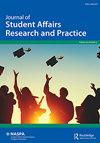亚洲岸蟹种群减少期间潮间带栖物种的种群动态
IF 0.8
Q3 EDUCATION & EDUCATIONAL RESEARCH
Journal of Student Affairs Research and Practice
Pub Date : 2023-05-31
DOI:10.47611/jsrhs.v12i2.4262
引用次数: 0
摘要
亚洲滨蟹(Hemigrapsus sanguineus)原产于亚洲东海岸沿岸的河口栖息地,在美国东北部沿海地区已经占据了广泛的范围。22年8月2日至22年11月14日,采用样方抽样技术,在3个采样点对血螯蟹(Hemigrapsus sanguineus)、大西洋岩蟹(Cancer irroratus)、海纹贝(Littorina littorea)和大西洋肋贻贝(Modiolus desmissus)等潮间带种群密度进行了测定。为了减少亚洲岸蟹的数量,从22年9月28日至22年11月2日,只在1号样本地点实施了一段清除期。在移除期间,亚洲岸蟹的统计数据(甲壳尺寸/性别比例)没有统计学上显著的变化(甲壳尺寸变化p = 0.181)。然而,在样本点1内,亚洲岸蟹种群密度将下降8%,而在样本点2则增加1%。样本点1的岩蟹种群密度将增加31%,而样本点2的岩蟹种群密度只会增加7%。采用Shannon-Weiner多样性指数计算有效物种数(ENS)。1号样点和2号样点的ENS变化差异较大(分别增加0.248 ENS和0.024 ENS),表明亚洲岸蟹种群的减少对潮间带生物多样性的增加起了作用。本文章由计算机程序翻译,如有差异,请以英文原文为准。
Population Dynamics of Intertidal Resident Species during a Reduction in Asian Shore Crab Population
Hemigrapsus sanguineus (Asian shore crab), which is native to coastal estuarine habitats along the east coast of Asia, have overtaken a wide range of the coast in the northeastern region of the United States. Intertidal population densities of Hemigrapsus sanguineus, Cancer irroratus (Atlantic rock crab), Littorina littorea (Common periwinkle), and Modiolus demissus (Atlantic Ribbed Mussel), among others, were measured at three sample sites from 8/2/22 to 11/14/22 using quadrat sampling techniques. A period of removal was enacted solely upon Sample site #1 from 9/28/22 to 11/2/22 to cause a reduction in the Asian shore crab population. During the period of removal, no statistically significant changes in Asian shore crab demographics (Carapace size/sex ratios) would be observed (p = 0.181 for carapace size changes). There would however be an 8% decrease in Asian shore crab population density within Sample site #1, comparative to a 1% increase at Sample site 2. Rock crab population density at Sample site #1 would increase by a relatively drastic 31%, whereas the Rock crab population would experience only a 7% increase at Sample site #2. The Shannon-Weiner diversity index was used to derive the effective number of species (ENS). There would be a drastic difference in change of ENS following the removal period at Sample site #1 (increase of 0.248 ENS), and the change of ENS at Sample site #2 (decrease of 0.024 ENS), suggesting the reduction in Asian Shore Crab population played a role in increased population diversity of intertidal resident species.
求助全文
通过发布文献求助,成功后即可免费获取论文全文。
去求助
来源期刊

Journal of Student Affairs Research and Practice
EDUCATION & EDUCATIONAL RESEARCH-
CiteScore
2.40
自引率
9.10%
发文量
50
期刊介绍:
The vision of the Journal of Student Affairs Research and Practice (JSARP) is to publish the most rigorous, relevant, and well-respected research and practice making a difference in student affairs practice. JSARP especially encourages manuscripts that are unconventional in nature and that engage in methodological and epistemological extensions that transcend the boundaries of traditional research inquiries.
 求助内容:
求助内容: 应助结果提醒方式:
应助结果提醒方式:


